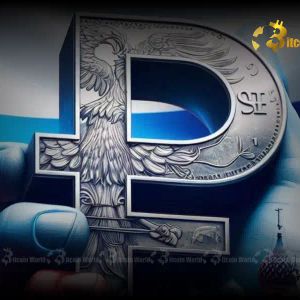Digital Ruble Set to Revolutionize Russian Payments by 2026: A Major Shift
6 min read
BitcoinWorld Digital Ruble Set to Revolutionize Russian Payments by 2026: A Major Shift The financial world is constantly evolving, and a significant tremor has just been felt from Russia. A groundbreaking law has been approved, mandating the rollout of the digital ruble and universal QR payments across the nation, with a firm start date of September 1, 2026. This isn’t just another payment update; it’s a foundational shift that could redefine how money moves within the Russian financial system , echoing ripples across the global economic landscape. What is the Digital Ruble and Why is Russia Embracing it Now? For those familiar with the fast-paced world of cryptocurrencies, the term ‘digital currency’ might conjure images of Bitcoin or Ethereum. However, the digital ruble is fundamentally different. It’s a form of Central Bank Digital Currency (CBDC), meaning it’s issued and backed by the Central Bank of Russia, just like physical cash or traditional bank deposits. Unlike decentralized cryptocurrencies, a CBDC is centralized and represents a direct liability of the central bank. So, why is Russia pushing for this now? The motivations are multifaceted, blending economic efficiency with strategic autonomy. For years, nations have explored CBDCs to modernize their payment infrastructure, reduce transaction costs, enhance financial inclusion, and gain greater control over monetary policy. For Russia, these benefits are amplified by its unique geopolitical context. A state-backed digital currency can offer a more resilient and independent payment system, potentially mitigating the impact of external financial pressures and sanctions. It’s a move towards bolstering financial sovereignty and innovation within the Russian financial system . Unpacking the Universal QR Payments Mandate: A Seamless Future? Alongside the digital ruble, the new law introduces a universal QR payments code. This is a crucial element of the grand design, aiming to simplify and standardize digital transactions across the board. Imagine a single QR code that works everywhere, regardless of your bank or the merchant’s bank. That’s the vision. Standardization: The mandate requires all banks and merchants to join the digital ruble platform and utilize this universal QR code. This means an end to fragmented payment systems where different apps or codes are needed for various merchants. Ease of Use: For consumers, making payments will become incredibly straightforward. Simply scan the universal QR code with your smartphone, confirm the amount, and the transaction is complete. No Client Fees: A particularly attractive feature is that banks cannot charge clients for using this QR code. This incentivizes adoption and reduces the cost of digital transactions for everyday users, making the digital ruble an appealing option for domestic transfers. Facilitating Digital Ruble Transfers: The QR code is designed to be the primary interface for initiating and receiving digital ruble transactions, ensuring widespread usability for the new currency. This universal approach to QR payments is a clear signal that Russia intends to create a highly integrated and efficient digital payment ecosystem, making the transition to the digital ruble as smooth as possible for its citizens and businesses. The Ambitious Rollout: A Phased Approach to Russia CBDC Implementing a nationwide digital currency system is no small feat. Recognizing the complexity, Russia has outlined a phased rollout strategy to ensure a stable and successful transition for its Russia CBDC initiative. According to Interfax, the timeline is clear: Phase Timeline Participants Key Action Phase 1 Starting September 1, 2026 Major Banks & Merchants Must support digital ruble transactions and universal QR payments. Phase 2 By 2028 Smaller Banks Gradual integration into the digital ruble platform. This staggered approach allows major financial institutions to iron out any technical kinks and gather user feedback before the system is fully expanded. It’s a pragmatic way to manage the massive undertaking of integrating a new form of money into the existing Russian financial system . The initial focus on major banks ensures that a significant portion of the population and commercial activity is covered from the outset, paving the way for broader adoption. How Will This Impact the Central Bank Digital Currency Landscape? Russia’s move into the realm of Central Bank Digital Currency is part of a broader global trend, yet it carries unique implications. While countries like China have already launched their digital yuan, and the European Central Bank is actively exploring a digital euro, Russia’s geopolitical position adds a distinct layer to its CBDC strategy. Globally, CBDCs are seen as a way for central banks to retain relevance in an increasingly digital world, offer a sovereign alternative to private digital currencies, and enhance the efficiency of payment systems. Russia’s digital ruble could serve as a blueprint or a cautionary tale for other nations considering similar paths, particularly those seeking greater financial autonomy. The development of a robust Russia CBDC system could also influence discussions around cross-border CBDC payments, though initial focus will undoubtedly be on domestic use. As more countries explore or implement their own digital currencies, the potential for new international payment corridors and agreements becomes a fascinating area to watch. Navigating the Future: Benefits and Challenges for the Russian Financial System The introduction of the digital ruble and universal QR payments holds significant promise for the Russian financial system , but like any major technological and regulatory overhaul, it comes with its own set of challenges. Key Benefits: Enhanced Efficiency: Instantaneous settlements, 24/7 availability, and reduced intermediaries can make payments faster and more streamlined. Reduced Costs: Eliminating certain fees and the need for physical cash handling can lower operational costs for banks and businesses, potentially benefiting consumers through lower transaction fees. Financial Inclusion: A digital currency can reach unbanked or underbanked populations more easily, provided they have access to a smartphone and basic digital literacy. Monetary Policy Control: The central bank gains greater visibility and potentially more granular control over money supply and circulation, allowing for more targeted economic interventions. Resilience and Sovereignty: A domestically controlled digital payment system offers a degree of insulation from external pressures and strengthens national financial independence. Potential Challenges: Privacy Concerns: As a centralized digital currency, transactions on the digital ruble platform could be traceable by the central bank, raising questions about individual privacy. Public Adoption: Overcoming inertia and building public trust in a new form of money will be critical. Education and seamless user experience will be key. Technological Infrastructure: Ensuring the robustness, scalability, and security of the underlying technology to handle nationwide transactions without glitches is a monumental task. Cybersecurity Risks: A centralized digital system presents a single point of failure that could be targeted by cyberattacks, necessitating top-tier security measures. Impact on Commercial Banks: There’s a potential for disintermediation, as some functions traditionally performed by commercial banks might shift to the central bank, requiring banks to adapt their business models. The success of this initiative will hinge on how effectively Russia navigates these challenges while maximizing the inherent benefits for its economy and citizens. It’s a delicate balance between innovation, control, and user acceptance. What Does This Mean for the Crypto World and Beyond? For enthusiasts of decentralized cryptocurrencies, the rise of CBDCs like the digital ruble often sparks debate. While both are digital, their fundamental philosophies diverge. Cryptocurrencies champion decentralization, anonymity (to varying degrees), and freedom from central authority. CBDCs, conversely, represent the ultimate form of centralized digital money, reinforcing the power of the state’s financial institutions. This move by Russia underscores a global trend: governments are increasingly embracing digital money, but on their own terms. It’s less about adopting blockchain’s decentralized ethos and more about digitizing fiat currency for efficiency and control. This could lead to a future where CBDCs coexist with, or even compete with, private digital payment systems and traditional banking. It highlights the growing digital transformation of money, pushing both traditional finance and the crypto space to adapt. The approval of the digital ruble and universal QR payments marks a pivotal moment for Russia. By 2026, the nation is poised to operate a modern, efficient, and centrally controlled digital payment system. This ambitious undertaking aims to strengthen the Russian financial system , enhance its resilience, and offer its citizens a seamless way to transact. While challenges remain, the commitment to this digital transformation is clear, positioning Russia as a significant player in the evolving global landscape of Central Bank Digital Currency . To learn more about the latest crypto market trends, explore our article on key developments shaping the future of digital finance. This post Digital Ruble Set to Revolutionize Russian Payments by 2026: A Major Shift first appeared on BitcoinWorld and is written by Editorial Team

Source: Bitcoin World



